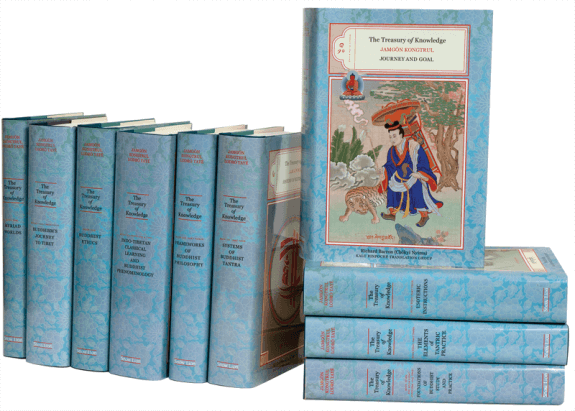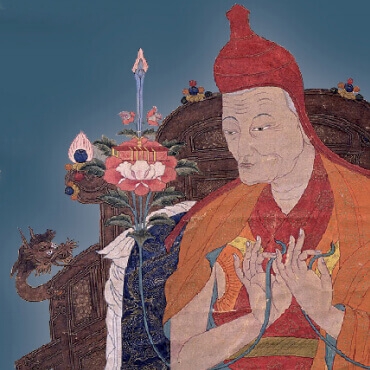The Treasury of Knowledge

This monumental translation—more than twenty-five years in the making—is at last complete. We are delighted to make available this comprehensive collection of the entire range of Buddhist teachings as they have been preserved in Tibet.
In Tibetan religious literature, Jamgön Kongtrül's Treasury of Knowledge in ten books stands out as a unique, encyclopedic masterpiece embodying the entire range of Buddhist teachings as they were preserved in Tibet. In his monumental Treasury of Knowledge, Jamgön Kongtrül presents a complete account of the major lines of thought and practice that comprise Tibetan Buddhism.
Book One: Myriad Worlds
This first book of The Treasury which serves as a prelude to Kongtrul's survey describes four major cosmological systems found in the Tibetan tradition—those associated with the Hinayana, Mahayana, Kalachakra, and Dzogchen teachings. Each of these cosmologies shows how the world arises from mind, whether through the accumulated results of past actions or from the constant striving of awareness to know itself.
Books Two, Three and Four: Buddhism's Journey To Tibet
Beginning with the appearance of the Buddha in our world (Book Two), it describes the Buddha's life, his enlightenment, and what he taught (Book Three) from a multitude of Buddhist viewpoints. Buddhism's transmission to and preservation in Tibet is the focus of the main part of this volume (Book Four), which describes the scriptural transmissions and lineages of meditation practice as well as the Buddhist arts that together make up the world of Tibetan Buddhism.
Book Five: Buddhist Ethics
This volume is the fifth book of that work and is considered by many scholars to be its heart. Jamgön Kongtrül explains the complete code of personal liberation as it applies to both monastic and lay persons, the precepts for those aspiring to the life of a bodhisattva, and the exceptional pledges for practitioners on the tantric path of pure perception.
Book Six, Parts One and Two: Indo-Tibetan Classical Learning and Buddhist Phenomenology
The first two parts of Book Six, contained in this volume, respectively concern Indo-Tibetan classical learning and Buddhist phenomenology. The former analyzes the traditional subjects of phonology and Sanskrit grammar, logic, fine art, and medicine, along with astrology, poetics, prosody, synonymics, and dramaturgy. The principal non-Buddhist philosophical systems of ancient India are then summarized and contrasted with the hierarchical meditative concentrations and formless absorptions through which the “summit of cyclic existence” can genuinely be attained. Part Two examines the phenomenological structures of Abhidharma—the shared inheritance of all Buddhist traditions—from three distinct perspectives, corresponding to the three successive turnings of the doctrinal wheel.
Book Six, Part Three: Frameworks of Buddhist Philosophy
This volume, Frameworks of Buddhist Philosophy, is his masterful survey of the broad themes and subtle philosophical points found in more than fifteen hundred years of Buddhist philosophical writings. In a clear and systematic manner, he sets out the traditional framework of Buddhism's three vehicles and four philosophical systems, and provides an overview of the key points of each system. His syncretic approach, which emphasizes the strengths of each of the systems and incorporates them into a comprehensive picture of philosophical endeavor, is well-suited for scholar-practitioners who seek awakening through the combination of analytical inquiry and meditation.
Book Six, Part Four: Systems of Buddhist Tantra
The tantric path is often referred to as the indestructible way of secret mantra, the essence of which is the indestructible union of wisdom (the understanding of emptiness) and method (immutable great bliss). This volume sets forth the various systems that constitute this path, both those of the ancient tantra tradition and of the new tradition.
Book Seven and Book Eight, Parts One and Two: Foundations of Buddhist Study and Practice
Foundations of Buddhist Study and Practice comprises Book Seven and Book Eight, Parts One and Two of the Treasury of Knowledge. Book Seven elucidates the various keys needed to correctly interpret, understand, and contemplate Buddhist teachings, including the secret teachings of the Vajrayana. Parts One and Two of Book Eight explain how the teachings are to be integrated into one’s life through the practice of meditation, which unites a state of one-pointed attention with profound insight into emptiness. Jamgön Kongtrul’s evenhanded, elegant, and authoritative statement of such controversial doctrines as unqualified emptiness (“self-empty”) and qualified emptiness (“other-empty”), provisional and definitive meaning, and conventional and ultimate truth as presented in the various schools of Tibetan Buddhism will appeal to both serious Dharma practitioners and advanced students and scholars.
Book Eight, Part Three: The Elements of Tantric Practice
The Elements of Tantric Practice sets forth the essential components of the path of highest yoga tantra, a system of meditation that unites wisdom and compassion in its two phases of practice. The first phase, that of creation, relies primarily on the use of the imagination to effect personal transformation. The phase of completion allows the practitioner to perfect the process of transformation by training in methods that manipulate the energies and constituents of the mind and body. The result of this path is the direct experience of the fundamental nature of mind and phenomena. The Elements of Tantric Practice concerns the meditative processes of the inner system of secret mantra—that of highest yoga tantra—and is based primarily on tantric sources. The author introduces the subject by describing the path of tantra and its underlying principles. The main body of the book deals with two major elements essential to all highest yoga tantras: the practice of the creation phase and that of the completion phase. For the first phase, Kongtrül describes the visualization sequences in which ordinary perceptions are transformed into the forms of awakening and explains how these practices purify the stages of cyclic existence—life, death, and rebirth. The creation phase prepares the practitioner for the techniques of the completion phase, which entail focusing directly on the channels, winds, and vital essences that form the subtle body. Kongtrül presents the key elements of a variety of tantras, including the Guhyasamaja and Yamari, belonging to the class of father tantras and the Kalachakra Hevajra Chakrasamvara Mahamaya Buddhakapala and Tara mother tantras. All these tantras share a common goal: to make manifest the pristine awareness that is the union of emptiness and bliss.
Book Eight, Part Four: Esoteric Instructions
This volume, Esoteric Instructions, deals with meditation—specifically tantric meditation. Esoteric Instructions is a collection of intimate records of personal teachings by masters that simplify tantric meditations by providing pertinent examples and very personal and helpful hints to disciples based on the master's own experience. Although originally oral in nature, they have been codified and passed down through specific lineages from teacher to student.
Books Nine and Ten: Journey and Goal
Journey and Goal focuses on the spiritual path—the journey and the resultant state of enlightenment to which it leads—the goal. Extensively varied perspectives are offered not only from within the many schools of Buddhism but also from the different levels of practice and attainment. This is in fact the most comprehensive treatment of these themes to appear in the English language.


